
Try Amazon Audible Premium Plus and Get Up to Two Free Audiobooks

Prelude
On November 17, 1805, Napoleon decided his army needed a little time to rest and reorganize. The Moravian town of Brünn seemed like a nice location, located due north of Vienna and close to the marshalling Russian army in Olmütz. Napoleon had received word that the Austrian Emperor, Francis, was currently in Brünn, and sent word that his advance would be delayed to allow Francis time to leave the city. The next day, Murat's cavalry won a decisive engagement against the Russian rearguard at Porhlitz, and entered Brünn the following day (November 19). Meanwhile, the rest of the pursuit slowed as French troops took in a day's rest. As luck would have it, Brünn was well stocked in supplies.
Murat and Bessiers pursued the Russians through the town of Wischau, pushing the Russian cavalry back to the army's center at Olmütz. The allied army at Olmütz consisted of Kutusov's pursued troops (36,000), Buxhöwden's army (30,000), and some Austrian forces under Prince Johann von Lichtenstein. The total allied army numbered roughly 86,000, and was nominally under the command of Tsar Alexander I, the Russian monarch.
The Austrians and Russians were uncomfortable allies. The Russians behaved more like an invading army while in Austrian territory, and held little respect for the Austrian military. Prussia began to stand down from the brink of war; not only did the allied defeats dissuade them from supporting a losing cause, but they were none to pleased with continued English activity in Hanover. They had hoped too that Napoleon would make them some sort of offer for not joining the Coalition.
Kutusov wished to continue the withdrawal, at the very least, relocating the army to a location that hadn't been heavily pillaged. The winter weather was beginning to take its toll, and sickness was beginning to run rampant over the exposed troops. Withdrawal was unacceptable to the Austrians, however, who wanted the French out of their homeland; and Russian hawks had the ear of the Tsar, who also supported a renewed offensive. On November 27, the Russians moved against Brünn, while Ferdinand and 9,000 tired troops moved south from Prague. Napoleon had centered his army in a position where it could react swiftly to a major attack from either the Tsar to his east, or the Archdukes Charles and John to the south. Massena was ordered to stay on Charles tail and keep his army of 80,000 (he had combined with John on November 26) from coordinating with the Russians at all costs. On November 25, the Austrians requested peace negotiations with Napoleon. Knowing full well this was a delaying tactic, he sent his own intelligence expert, General Savary, to the Russian camp to assess their capabilities while the Austrian delegates were sent to Vienna to talk to Talleyrand.
Savary confirmed that the Russians were mobilizing earlier than expected, but Napoleon was determined to meet them and on his terms. Murat and Soult were ordered to withdraw behind the Goldbach River (a small stream or brook), leaving outposts on the Pratzen Heights. The French army still had not concentrated in the area, and Napoleon was prepared to withdraw if the allied attack came before December 1, when Bernadotte and Davout would be available after a forced march. The Russians moved at a glacial pace, however, and on November 30, their lines were still in disarray. Alexander offered Napoleon terms to call off the battle which included his evacuation from Italy and Belgium. Napoleon refused, but gave the impression of being greatly concerned. As a final show for the Russian observers, he ordered Soult to evacuate the town of Austerlitz and the high ground of the Pratzen Heights, and to do so with the appearance of disorder and haste. Napoleon didn't simply want another victory…he wanted to bag the entire allied army.
The allies took the bait, hook, line and sinker. Soult's withdrawal gave the appearance of a weak right flank on the French line. Napoleon had around 50,000 men to the ally's 86,000. The allied army slowly advanced, occupying Austerlitz and the Pratzen Heights. The allies thought the French to be half-beaten, which would account for their curious withdrawal from such advantageous ground. From their position, however, much of the French army was obscured from view. Allied plans called for an enveloping assault on the French right, rolling up the line from the flank. Kutusov advised a more cautious approach to the battle, but the Austrians were desperate for revenge, and the Austrian commanders present, Weyrother, Kollowrath, and Keinmeyer, all had Tsar Alexander's ear. The Russian monarch was not much of a military man, and he likely was present in the pursuit of excitement, so he favored the hawks over his more esteemed Commander-in-Chief.
By November 30, Bernadotte's I Corps would arrive (less Wrede's division of Bavarians, who were left behind as a rearguard should events not go as planned), putting La Grande Armee's strength over 60,000. Davout was ordered to force-march from Vienna, and they would actually arrive as the battle was in progress, boosting the French strength to a more equitable 73,000.
|
La Grande Armée d'Allemagne Commander-in-Chief: Emperor Napoleon I |
||
| The Imperial Guard | Marshal Jean Baptiste Bessieres | 5,500 men, 24 guns |
| I Corps | Marshal Jean Baptiste Bernadotte | 13,000 men, 24 guns |
| III Corps | Marshal Louis Nicholas Davout | 6,300 men, 12 guns |
| IV Corps | Marshal Nicholas Jean de Dieu Soult | 23,000 men, 35 guns |
| V Corps | Marshal Jean Lannes | 12,700 men, 20 guns |
| Grenadier Division | General Nicholas Charles Oudinot | 5,700 men |
| Cavalry Reserve | Marshal Prince Joachim Murat | 7,400 horse, 36 guns |
|
|
||
| Army of the Two Emperors
Nominal Commanders-in-Chief: Tsar Alexander I and Emperor Francis II |
||
|
|
||
| Russian Imperial Guard | Grand Duke Constantine | 6,830 men, 3,700 horse, 40 guns |
| Advance Guard of the Tsar's Army | Lt. General Peter Bagration | 9,200 men, 4,500 horse, 42 guns |
| Advance Guard of Buxhöwden's Army | General Michael Keinmayer | 3,440 men, 3,440 horse, 12 guns |
| First Column | Lt. General Dmitri Doctorov | 13,240 men, 250 horse, 64 guns |
| Second Column | Lt. General Andreaux Langeron | 11,250 men, 300 horse, 30 guns |
| Third Column | Lt. General Pryzbyswski | 7,700 men, 30 guns |
| Fourth Column | Lt. Generals Kollowrath & Miloradovich | 23,900 men, 76 guns |
| Fifth Column | Lt. General Prince von Lichtenstein | 5,375 horse, 24 guns |
The Allied Plan
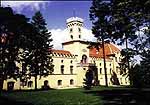 The main assault would be to the south, or French right, with 59,300
men under the command of General Buxhöwden. The advance guard (5,100)
would be led by General Keinmeyer, followed closely by Doctorov's First
Column. This force was to capture the town of Tellnitz on the extreme
right of the French line, then turning north to link up with Langeron.
The Second and Third column would assault Sokonitz and its environs
(including the castle and pheasantry). All three columns would then
combine and move north against Kobelnitz.
The main assault would be to the south, or French right, with 59,300
men under the command of General Buxhöwden. The advance guard (5,100)
would be led by General Keinmeyer, followed closely by Doctorov's First
Column. This force was to capture the town of Tellnitz on the extreme
right of the French line, then turning north to link up with Langeron.
The Second and Third column would assault Sokonitz and its environs
(including the castle and pheasantry). All three columns would then
combine and move north against Kobelnitz.
At this point, the French line would resemble a right angle centered at Puntowitz. Kollowrath and Miloradovich would descend from the Pratzen Heights with 23,900, aiming to break the French line at Puntowitz. To the north, Bagration was to slowly advance with 13,000 troops, and Prince Lichtenstein's cavalry would provide a link between the northern and southern armies. Meanwhile, Grand Duke Constantine would remain in reserve with the Russian Imperial Guard.
Formulated by the Austrian chief-of-staff Weyrother, the Allied plan was complex and would prove difficult to coordinate among leaders speaking different languages. The French ex-patriot Langeron objected to abandoning the Pratzen Heights, but was overruled by the Austrian generals, who firmly believed that the French army would offer no serious resistance. Field commander General Kutusov slept through most of the briefing. Indeed, the allies had no idea that Bernadotte had arrived and his I Corps was perched behind the Santon, nor that Davout's III Corps was about to arrive on the scene.
The French Plan
To the north, Marshal Lannes' V Corps was to hold at all costs against Bagration's advance. Protecting his flank would be the cavalry reserve under Prince Murat. In the south, 12,000 men of the IV Corps under General Legrand was to hold the line, reinforced by General Louis Friant's division and the corps cavalry from Davout's III Corps, bringing the local force to around 18,600. Bernadotte's I Corps would come out of concealment and attack the town of Bläsowitz, north of the Pratzen Heights. The remainder of Soult's IV Corps, the divisions of Vandamme and Saint-Hilaire, would emerge from the mist on the eastern bank of the Goldbach River near Puntowitz and attack the allied center. Oudinot's grenadiers and the Imperial Guard would form a reserve. After occupying the Pratzen Heights, the French troops were to descend upon the flank and rear of Buxhöwden's army, destroying it in an enveloping attack.
The Battle
Dawn arrived late on December 2, a heavy fog shrouding the battlefield. Austrian and Russian troops began their maneuvers, but quickly became disordered after crossing each others lines of communication. When asked by the Tsar why Kollowrath and Miloradovich had not yet begun their descent from the Pratzen Heights, an agitated Kutusov replied, "Your highness, I am waiting for all of the other columns to get into position."
Fighting began with Keinmeyer's advance guard leaving Aujest Markt at 0600 and advancing on Tellnitz. Here the Austrian commander was opposed by Legrand's 3rd Infantry regiment and the Corsican Light Infantry. After an hour (0700) the French still held Tellnitz. As Doctorov's column approached, the heavily outnumbered French executed their orders to withdraw. Fourteen squadrons of Austrian cavalry poured past Tellnitz, where they were met by the three regiments of IV Corps light cavalry under General Margaron, who in turn gave ground, pulling back to the north. Doctorov sent word back that the French were giving ground everywhere; and that so far, the attack was going according to Weyrother's plan.
Doctorov had halted, however, awaiting the appearance of Langeron to his right. The Second Column, however, was delayed when it became apparent that Lichtenstein's cavalry had camped at the wrong spot, and had to be repositioned, blocking the path. At this time, Friant's division arrived on the scene (initially suffering friendly fire from Legrand's troops, who thought them to be Austrians) and immediately launched an attack against Tellnitz, regaining the town briefly before withdrawing. By now, Langeron had arrived and duly occupied Sokolnitz, and further north, Pryzbyswski's Third Column was attacking Sokolnitz Castle and the pheasantry. While execution was slower than anticipated, the Allied fortunes still seemed to be going according to Weyrother's plan.
Convinced that timing is everything in a battle, the Allied timing was way off and Napoleon could not be happier. The Allies had now begun crossing to the west bank of the Goldbach and were immediately counterattacked by the III Corps six regiments of dragoons under General Bourcier. This was immediately followed by an assault by Heudelet's Infantry Brigade under the personal command of Marshal Davout. The counterattack succeeded in disrupting Doctorov's column and regaining the village of Tellnitz. Meanwhile, General of Division Friant launched Lochet's Brigade into Langeron's flank and rear, ejecting them from Sokolnitz and pushing them back to the east bank of the Goldbach. All in all, about 10,300 French troops had stopped then defeated an army of more than 50,000 who moments earlier had thought themselves to be victorious. By 10 am, the French had reoccupied all of the Allied objectives, and the flank attack was officially a failure.
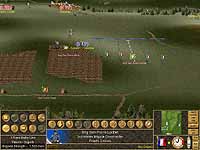
|
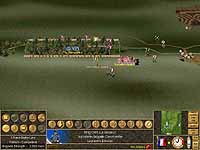 |
| Lochet's Brigade of General Friant's Division advances on Sokolnitz. | Meanwhile, Lavasseur's 3rd Brigade (Legrand's Division) attacks the Allied flank near the castle. |
Meanwhile, Napoleon watched from his command post at Zurlan as the Allies emptied their center to execute the massive flanking maneuver to the south. The divisions of Saint-Hilaire and Vandamme remained hidden, and the Allies showed no indication that they were aware of their presence. When asked how long it would take for these troops to occupy the Pratzen Heights, Soult replied, "less than 20 minutes, sire." By 0900, the bulk of Buxhöwden's army was engaged or well in motion. Napoleon told Soult, "One sharp blow and the war is over."
Napoleon then turned to his staff officers. "The enemy is more numerous than ourselves," he observed, pointing south. "They expect to attack and vanquish me. No-its more-not only to beat us but cut us off from Vienna and round up the French army! They think I am a novice! Well, they'll come to regret it. Come on! Let us put an end to this campaign with a crash of thunder that will stun the enemy!"
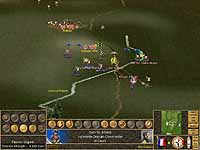
|
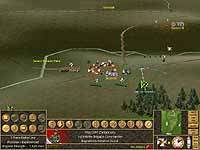 |
| St.Hiliare approaches Pratzen against light resistance. | Major General Delgoruky approaches Bozenitz as lead elements of Bagration's Advance Guard move on Santon. |
To the north, Lannes and Bagration met with neither force gaining the upper hand. Lichtenstein was ordered to offer support, and when he arrived, promptly charged some French light cavalry, who withdrew through between some infantry squares that stopped the charge. Shortly afterwards, he was ordered back to the center, where Vandamme and Saint-Hilaire had broken Miloradovich and Kollowrath's forces on the Pratzen Heights.
Lichtenstein was determined to close the developing gap between Bagration's advance guard and the remainder of the Allied army, and marshaled 4,000 cavalry in a massive charge against Lannes' V Corps. At point-blank range, however, the divisional and regimental artillery opened fire, mauling the densely-packed cavalry and sending them into retreat, where they were rallied by General Uvarov. General Kellerman's light cavalry attempted to maintain pressure on the Allied troops, but were counter-charged by Lichtenstein. The cavalry withdrew through intervals opened by Caffarelli's infantry, which immediately closed up the gaps and opened fire on the pursuing Allied horse. Kellerman's squadrons reformed but were then assailed by Russian hussars and dragoons. In the ensuing melee, Prince Murat and his staff were forced to draw their sabers and defend themselves. The situation was saved by the arrival of General Etienne Nansouty's Heavy Cavalry division; his carabineers and cuirassiers chasing off the leading elements of Lichtenstein's force. Nansouty then withdrew behind Caffarelli's infantry to rest and regroup. Lichtenstein sent his next group in to attack, but Caffarelli had formed a square, checking the charge. Once again, the lines opened up and Nansouty's heavies charged through, sending Lichtenstein's troops into a full route. It was now 1030.
In the center, the battle was beginning to reach its climax. Approaching Austrians from Langeron's Second column, under the command of Major-General Kaminsky and claiming to be allied Bavarians, were allowed to get within 150 yards of General Thiébault's 36th line regiment before the 12pdr artillery opened fire, tearing massive holes in the line. The ensuing battle raged for 30 minutes, as Saint-Hilaire was prevented from withdrawing by an Austrian attack on the south. The Austrians finally had enough and pulled back, only to be reinforced by two battalions of the Kursk Regiment as well as the Podolia regiment. The French, however, were in complete control of the situation along the Goldbach, and General Legrand was able to spare General Levasseur's Brigade to assist. The Kursk Regiment was crushed, losing 1,550 men, its guns, and its colors while the Podolia fled downhill only to be stopped by the stone walls of the pheasantry. Langeron hurried back to a drunken General Buxhöwden to report the situation, and was ridiculed by the army commander in a heated exchange.
The last card to be played by the Allies was committing the giants of the Russian Imperial Guard. First ordered to contest Vandamme in a show of force, evaporating fortunes prompted Grand Duke Constantine to commit the entire reserve. The grenadiers of the guard attempted to rush the elevated feature known as Staré Vinohrady and managed to breakthrough Vandamme's 3rd brigade before being repulsed by artillery. Vandamme then ordered the 4th line regiment to pursue and prevent the Russians from reforming; a move that was duly met by a charge by the 15 available squadrons of the Guard Cavalry with 1000 cuirassiers. The leading battalion formed a square to meet the charge, but at the last second, the cavalry veered off to reveal horse artillery which opened fire on the square using canister shot. Vandamme attempted to reinforce with the 24th regiment, but it was too late and the 4th broke. The gap was filled by Napoleon's own Imperial Guard, with Marshal Bessières sending Colonal Morland with three squadrons of chasseurs-à-cheval, three of grenadiers- à-cheval and a battery of horse artillery. Constantine countered with Chevalier Gardes (a formation comprised of noble-born horsemen) and the Guard Cossacks. When the Semenovsky and Preobrazensky Life Guards re-entered the combat, the French Guard cavalry suddenly found themselves under attack on three sides, and its commander, Colonel Morland, struck dead. The grenadiers and horse artillery managed to extract the chasseurs, but only after heavy losses were taken.
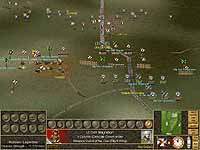
|
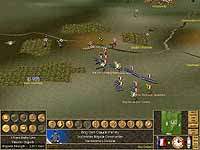 |
| Nansouty's heavy cavalry storms through Caffarelli's infantry as Bagration and Lichtenstein brace for the onslaught. | Constantine's Imperial Guard assaults Vandamme's position near Stare Vinohrady. |
The situation at the moment appeared bleak. Saving the day, however, was I Corps Drouet d'Erlon's leading brigade under the command of Colonel Gérard. Napoleon, Soult and Bernadotte would all claim credit for this fortunate tactical stroke, which allowed time for the situation to stabilize. Napoleon then ordered more Guard cavalry into the fray, with his senior aide, General Jean Rapp, leading two squadrons of chasseurs and the spectacular Mamelukes of the Guard regiment, adorned in their oriental splendor. Another detachment of grenadiers was also sent in to support the chasseurs. In one instance, d'Erlon's brigade turned back an audacious attempt by Russian cavalry to ride through their ranks and attack the reforming chasseurs. With the Chevaliers engaged in hand-to-hand combat and faring poorly, the Guard infantrymen could not bring their muskets to bear out of fear of hitting their comrades. Suddenly, the Russian Guard broke, retreating at full tilt towards Krzenowitz, due west of Austerlitz. Had it not been for Bernadotte's typical inaction, the entire Russian Guard could have been destroyed at that moment. Instead, the Marshal halted his troops at the edge of the Pratzen Heights, observing the Russian retreat.
It was now about 1400 hours, and the Allied center had ceased to exist. To the north, Bagration had withdrawn eastward in good order, and it was no longer convenient for Napoleon to proceed with his original plan of enveloping and destroying this unit. Bernadotte was ordered to deploy on the Pratzen and Staré Vinohrady, while Saint-Hilaire, Vandamme, and the Imperial Guard were to turn south and set about the destruction of Buxhöwden's army. With expert timing, Friant launched an attack on Sokolnitz with the 33rd regiment, and surviving elements of the 48th, along with remnants of the Tirailleurs du Pô and Corses (light infantry of the Po and Corsica). This assault penetrated as far as the castle, and sent the disorganized Allies, now without a working command structure, into general panic. They were just now becoming aware of the French troops marching towards them off the Pratzen.
The Allied advance was marred by traffic snarls and chaos, and its attempted withdrawal was far worse. Pryzbyswsky found himself under attack from the rear by the 36th regiment, and 4,000 troops were forced to surrender. Doctorov, Kienmayer and Langeron were engulfed by Friant, Saint-Hilaire, and Vandamme, with Marshal Davout ordering "let no one escape." Vandamme was ordered to seize Aujest Markt, the only viable avenue of retreat. The general executed these orders despite taking heavy casualties from a large Russian battery (claimed to be as much as 50 guns). "You cannot make omelettes without breaking a few eggs," Vandamme remarked.
The main avenue of retreat blocked, the Allies began withdrawing towards the frozen Satschan ponds. Napoleon had deployed 25 cannon overlooking the scene. There were few avenues of passage through the ponds, and one bridge collapsed under the weight of a retreating artillery piece. Another causeway was blocked when a howitzer shell struck an ammunition cart, causing a massive explosion. Men and horses began crossing the frozen ice, and Napoleon ordered his cannon to be loaded with hot shot (iron balls heated until red hot). Shelling the ice, the resulting havoc resulted in numerous casualties, particularly among horses. 38 cannon were recovered from the waters afterward. Buxhöwden would escape with just 2,000 men, or 6% of his original command.
Aftermath
Casualty figures were about 2,000 dead and 7,000 wounded and one colour (4th
line/III Corps) for the French, and 16,000 dead and wounded and 45
colors lost for the Allies. 30,000 prisoners were also taken by the French.
The following day, Emperor Francis
requested an audience with Napoleon. The French set out in pursuit of
the Russian army, and eventually Davout caught up with Kutusov, but
spared the army under assurance that an armistice had been concluded
(it had not). On December 4, Napoleon and Francis concluded an
armistice to immediately end hostility between French and Austrian
troops, and extended the provisions to the Russian army if they agreed
to return to their own soil.
On December 26, the Peace of Pressburg is concluded. In reparation,
Austria was ordered to cede to France the territories of Cleve and Berg
along the Rhine, the Alpine region of Neuchatel, and Trieste and
Dalmatia along the Adriatic Coast. Bavaria, meanwhile, was to gain
Swabia and Wurzburg.
The Third Coalition was essentially at an end. Its architect, William
Pitt the Younger, devastated by the events of Austerlitz and the
outcome of the 1805, died several weeks later in January of 1806. The
Prussians would enter the picture all too late, much to their eventual
misfortune as Napoleon's victories would continue on the fields of Jena
and Auerstadt.